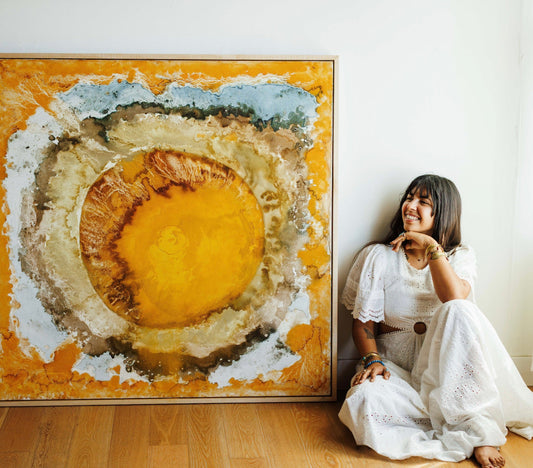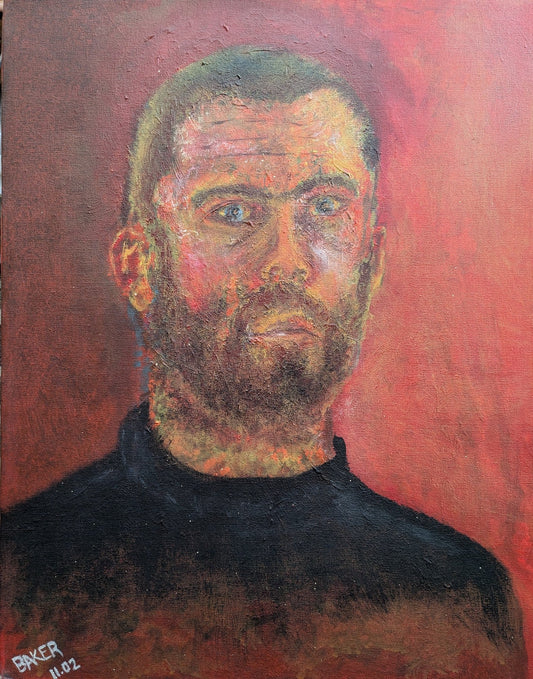Sophie Pearson
Between trends like coquette and the release of the “Barbie” movie, it seems that the past year has truly been the year of girlhood. One of the beautiful things about the concept of girlhood is that while many events and motifs are agreed to be a universal experience of growing up as a girl, there is still room for our personal narrative and experiences to be tied into this idea as well. 26-year-old Sophie Pearson’s paintings capture the whimsy, nostalgia, and occasional aching sadness of girlhood through pastel-colored pieces that document both herself and her childhood.
When looking at her collection of work, it’s clear that Pearson reflects on her existence quite often. Gazing upon her work is almost reminiscent of reading a diary left on her bedside table. It’s incredibly intimate and vulnerable, and as a viewer, I feel that there’s almost a sense of intruding within Pearson's private mind. Yet this same vein is what makes her work so captivating. The main subject throughout her work is herself. However, this is not done in a narcissistic way; it is more in a self-reflective way that invites viewers to reflect upon themselves as well.

“I have tried in the past to paint other people, I've tried commissions, I've tried all sorts of stuff trying to get myself to branch out,” explains Pearson. “It always comes back to the fact that I put so much emotion into my work, and I feel so much while I'm making my work, and unless I have that really deep connection with the person I'm painting, I feel like I can't. I feel like I'm not coming from a place of complete and utter sincerity and knowing.”
Pearson notes that one of the only other people she’s able to paint is her husband because they share the level of intimacy she requires to capture what she feels is someone's essence. She began primarily painting herself after graduating from art school. She describes it almost as a compulsive need to capture the images that would enter her mind, and at the time, she found herself thinking of the imagery of her body.
Throughout centuries of art history, portraiture work, like Pearson’s, seemed to highlight what the societies of the time claimed was an “ideal” body. The Renaissance had supple, rounded bodies, while the early 1900s tended to highlight thin, waifish frames. Pearson understands that her body does not fit the current beauty standard. Yet she knows beauty and visual interest still demands to be captured in it.

In her piece “What I Would Do,” Pearson portrays an unsettling image of scissors pressing into her stomach, a pervasive desire to cut away the sections of her body that were prodding her mind at the time. It is an image that feels almost grotesque to sit with as you imagine what the next motion of the scissors would be if they were actually to cut the stomach. But it’s also a hauntingly familiar feeling to those who’ve experienced the same contemplation over their own forms. Part of what makes this piece so captivating is the unique visual aspect Pearson is able to create through her body.
“I wanted to really feel the form of my stomach, I knew that having a larger stomach was something that would lend to shape,” says Pearson. “Take away the meaning of the painting, take away the fact that I'm fat and that this is a figure painting; it would still be inherently visually interesting painting just because my body is capable of making so many squishy round forms.”
Pearson uses her body almost like clay, molding herself to the forms that fill her mind and fanatically capturing the different angles and perspectives. Her paintings hold a large visual interest through shape alone, but adding these narrative moments and meaning makes the work that much more enticing. Pearson has had her share of viral fame for her work, which has introduced her to both the joys and pitfalls of a successful internet presence.

On one hand, much of her work ends up in the camp of body positivity. People see her paintings and are able to identify themselves within the pieces. She’s received thousands of comments from people praising her for showing a body that looks like theirs or that her own acceptance has allowed them to accept themselves. On the other hand, she notes that she’s received a significant amount of comments that feel entitled to provide their own opinions on Pearson’s personhood based on the presentation of her body.
“People tell me that I am dying, that I should die, that I am a horrible person, that I'm promoting obesity, that my trauma isn't real,” lists Pearson. “I've had people tell me that I shouldn't be in therapy because being fat is not traumatic, that having an eating disorder isn't possible for someone like me.”
Pearson notes that so often, when a fat woman shows any part of her existence, it is angrily labeled as promoting obesity or promoting an unhealthy lifestyle. Pearson herself does not outright label her work in any body positivity camp. She enjoys that the images can resonate within this community, but at the end of the day, her body should be objective in her art.
“I don't think that painting my body as it looks right now is a promotion of anything,” says Pearson. “It's just so hard for me to grasp the concept of people saying that it's promoting obesity, or saying that it's a bad thing to post these kinds of works, or just to be yourself on the internet. I think it's just hard for me to even rationalize what's going on in their head to be so violent.”
The positive reaction and outpouring of love she’s received is enough to help her keep the negative impact of this mindless hate away from her creative process. Hearing how her work has positively impacted or resonated with others is a bittersweet affair. She uses her art as a vehicle for processing herself, her emotions, and the events she’s lived. Not all of these moments are happy ones, but they all have led her to become the artist she is today.

In her piece “Her Only Meal,” Pearson portrays a still life featuring a bottle of Diet Coke and half a grapefruit. She describes the painting as being an “if you know, you know type of piece,” but the unspoken meaning is a commentary on her own struggles with disordered eating, body image, and diet culture. When her audience shares that they understand and relate to the work, it's pieces like this that Pearson feels brought back to reality. Sometimes, she finds that the most vulnerable part of sharing her work is imagining how those who share her experiences and emotions will feel when seeing that take form in art.
“I’m being so loud about who I am by posting something on the internet and letting people see it, especially with that image, that painting specifically. It's kind of one of those things where like, if you get it you get it if you don't, I'm happy for you,” says Pearson. “But in putting that work out, I had to step back and think like, ‘how are the people who get this going to react to it?’”
Her relationship with her body and food aren’t the only difficult subjects she processes with art. Lately, Pearson has been exploring her inner child and what growing up in a tumultuous home environment did to her perception of her childhood. Her recent series captures moments from her childhood. A childlike innocence is cast over the image, giving a blurred mix of reality and the fuzzy memory of recalling her past. In this series, her mother is represented by the silhouette of a blue figure, while her father is represented by a red figure.

It’s meant to be a reflection of how the child artist saw her family while growing up. The colors are meant to simplify her perceptions of them. Red for her father represents both the positives and negatives of his passion, anger, and loudness. Blue for her mother represents the quiet nature and sense of sadness that Pearson felt from her as a child. Drawn over top of these parental silhouettes are crayon-like markings that give the audience a deeper sense of how the eyes of a child interpret the actions of their parents. Pearson explains it as this being how she brings her inner child into the piece and allows them to speak.
“My adult self can look back retrospectively and like to see things that were either abusive or traumatic for what they are and the damage that they did,” says Pearson. But the inner child is innocent, she didn't know what was happening to her. Her parents were frustrating and angry and whatever, but she loved them; I tried to put that into my work. An inner child, for me, is someone who is innocent and loving and caring and just inherently good.”
Getting into the creative mindset to execute technical skills while still infusing her work with such openness and emotion requires somewhat of a ritual. Before she begins working, Pearson likes to channel the feelings of the painting through music. She shared her current playlist that’s been on repeat for this process is called “Songs to Show My Therapist.” This goes back to how she only paints what she truly feels emotionally connected to. Sometimes, it just requires a little extra help getting there.

Becoming an artist was a natural progression for her. As a child, art was a source of fun and comfort. She loved finding new crafts and mediums to experiment with. By the time college came around, she knew that it was only natural for her to continue her practice. She doesn’t exactly have a full progress map of where she’d like her artist career to take her, but she knows that the path she’s on currently makes her happy.
“I'm very much someone who thought that my life was ending at 19, and I didn't see a future for myself. So to be where I am now is just pretty remarkable,” says Pearson. “I'm a go with the flow kind of gal and of course I'd like to be successful, and I'd like to be an artist for the rest of my life. I hope that's something that I can do, but I don't want to set hard expectations for myself.”
Right now, all Pearson wants from her art is to honor her visions and provide her audience with a newfound peace of mind or perspective. She acknowledges that everyone’s perception of her work will be different based on their lived experiences, but ultimately, people take what they need emotionally.
As healing as her work is for herself, Pearson’s work is just as healing for the community she’s curated. She invites everyone to reflect back on the youngest age they remember, and to compartmentalize how that child’s view of the world and events has brought you to where you are now. If given the chance to talk to any version of her younger self Pearson would want to provide comfort, proof that it does get better.
“I wish I could just put my hands on little me’s shoulders and just say like, it works out. Whatever is happening, it's okay, you get through it and good things happen,” says Pearson.
Sophie Pearson will display her works in a solo show with Art Worscester from May 9 through June 16. You can learn more about Sophie Pearson through her Instagram and website.





